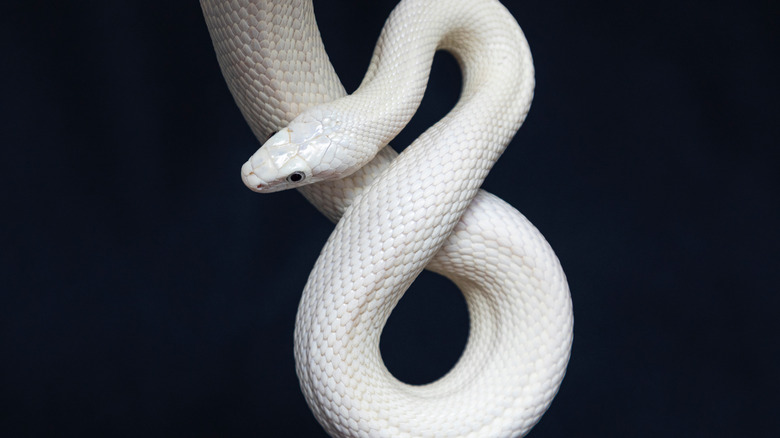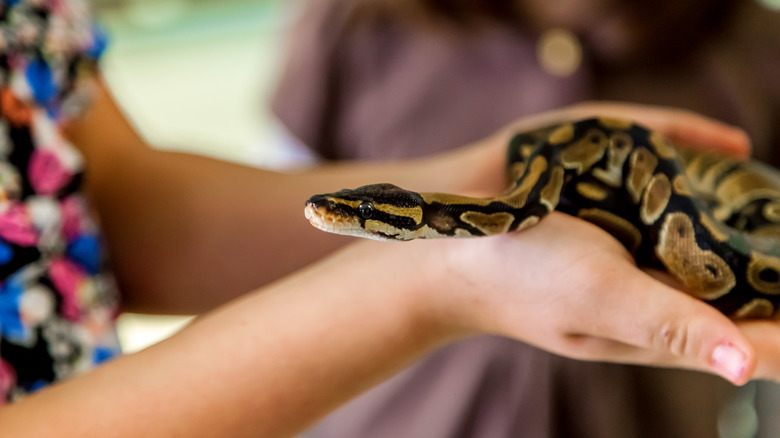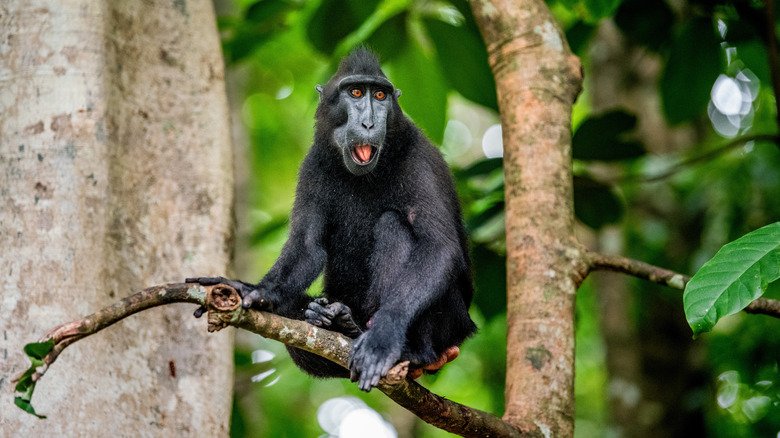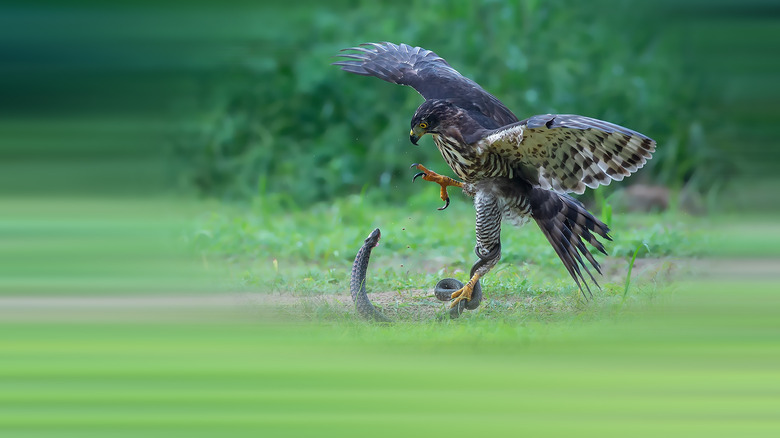The Real Reason You're Afraid Of Snakes
In ancient times, the serpent represented not only danger but deep healing — the skin-shedding reptile featured prominently in the Bible as a symbol of sin, wisdom, death, and resurrection, according to a 2011 abstract published in the World Journal of Surgery. Many of us are likely to experience some trepidation around snakes. But for some, even the mere mention or thought of a snake sends a shiver down their spine.
A fear of snakes, also known as ophidiophobia, is one of the most common and intense phobias out there (via Scientific Reports). According to research, one-third of British children are afraid of snakes, yet, the reptiles are hardly ever sighted in the U.K., and the venomous species are extremely rare. Those who have this particular phobia may begin to shake, cry, or have difficulty breathing when confronted with a snake (via Verywell Mind). So, where did this prevalent phobia stem from? Its origins may be easy to pinpoint for some and an absolute enigma for others. While researchers continue to study the reasons for ophidiophobia, here are a few science-backed explanations for why snakes may give you the creeps.
Even babies appear to have a natural fear of snakes
A 2017 study published in the Frontiers in Psychology tested the reactions of six-month-old infants when they were shown pictures of snakes against white backgrounds. The babies consistently responded to the images with much larger pupils than when they looked at photos of flowers or fish. The change in pupil size signifies the activation of the noradrenergic system, which is a part of the brain that handles stress, noted the researchers. This shows that the infants were in a heightened state of physiological arousal when looking at the creepie crawlies.
According to the study's researchers, the heightened arousal in reaction to images of snakes suggested "an evolved preparedness for developing a fear of these ancestral threats." In speaking with National Geographic about the study, lead researcher Stephanie Hoehl explained that this innate arousal in infants points to 40 million to 60 million years of human evolution that occurred alongside dangerous snakes and spiders. This long period of time for humans and snakes to co-evolve allowed this fear to serve as a defense mechanism.
An evolutionary explanation
Fear is adaptive in that it helped protect our ancestors. This explains why we have a natural disposition to fear risky animals like snakes. But if we were simply born with this anxiety, what about people who cozy up to them as pets? A snake phobia, while common, isn't universal (via Scientific American).
In recent years, researchers have offered a more refined evolutionary theory to make sense of this discrepancy. Based on the findings of a 2018 study published in the Journal of Cognition and Development, infants have an evolved perceptual bias for detecting a snake as a threat and associating it with fear. However, babies don't automatically recognize the slithering creatures as dangerous -– they're conditioned to do so by seeing the fearful responses of adults around them or by making a connection between a snake and an unpleasant stimulus like a scream. In other words, an infant learns from its environment that he or she is "supposed" to respond with fear to snakes.
Interestingly, this study indicates that babies don't have the same instinctual tendency to quickly spot other potentially threatening creatures, such as sharks or rodents. This might be because humans have lived alongside snakes and spiders for far longer than many of today's dangerous animals: "The fear of snakes may have its origins in mammalian evolution when such threats were prevalent and recurrent threats to survival," the study author points out.
What happens to the brain?
The pulvinar has been identified as a special part of the brain that's able to identify snakes as scary (via PNAS). This is an area of the thalamus, a region that's particularly developed in primates. It's suggested that the pulvinar enables us to process visual information and directs our attention to threatening or risky stimuli in the environment. The pulvinar is also connected to the amygdala, an almond-shaped structure that's involved in the processing and expression of emotions associated with fear and anger (via Smithsonian Magazine).
A 2013 study published in the journal PNAS tested the theory that the pulvinar might be the brain region responsible for your snake phobia. The researchers inserted electrodes into the pulvinar neurons of macaque monkeys that had never seen a snake before. They measured the animals' neuronal responses as they showed them images of threatening monkey faces, monkey hands, geometric shapes, and snakes. It appeared that a greater number of neurons fired strongly and synchronously when the animals gazed at the pictures of snakes, in comparison with the other images.
An important part of our ecosystem
It's important to remember just how remarkable snakes actually are, notes the George Institute for Global Health. Acting as both predator and prey, the scaly reptiles help us humans in a variety of ways. They play an integral role in the ecosystem: They help keep disease-carrying rodents and tick populations in check, providing a natural and eco-friendly pest control method. They also have predators of their own and serve as food for skunks, wild boars, and many different bird species, as well as other snakes.
While most snakes aren't venomous, it's generally a good idea to err on the side of caution and keep a safe distance if you do happen to come across one. "All outdoor (even in your yard) encounters with nonvenomous snakes should be resolved by letting the animal go its own way, most likely to never be seen again," advises the Humane Society of the United States. If you need to remove a snake from your garden or property, reach out to your local animal control agency for advice and information. Attempting to kill a snake is both unnecessary and bad for the environment, but it also could put you at greater risk of being harmed, as the animal could try to bite you in attempting to protect itself.
Ways to manage your fear
There's evidence that psychotherapy, and in particular cognitive-behavioral therapy (CBT), is an effective treatment for specific phobias in both adults and children (via Frontiers in Psychiatry). For some people, ophidiophobia may include some pretty strong physical and emotional symptoms that can get in the way of day-to-day functioning. Exposure therapy has been found to work well in treating a snake phobia a 2013 study published in Cognitive Behaviour Therapy shows that it can even yield positive outcomes when delivered via the internet. The technique falls under the umbrella of CBT, whereby a therapist supports the patient in coping with their fear through step-by-step exposure to a snake in a safe environment, breaking the pattern of avoidance that often maintains their phobia over time.
While phobias are rooted in adaptive responses, the profound anxiety that some people feel isn't proportionate to the actual perceived threat. The good news is there are evidence-based ways that people can use to manage and gradually overcome their phobia.






